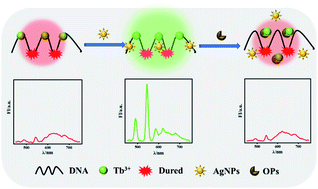A lanthanide-based ratiometric fluorescent biosensor for the enzyme-free detection of organophosphorus pesticides†
Abstract
Organophosphorus pesticides (OPs) residues have caused great concern as they cause great harm to public health. Herein, a ratiometric fluorescent sensing system was developed for the OPs detection with the merits of enzyme-free, simple operation, short-time and sensitivity. The change in the fluorescence signal in the sensing system was provided by guanine-rich DNA (G-DNA) and silver nanoparticles (AgNPs) with terbium ion (Tb3+) and dured. Tb3+ coordinated with the G-DNA to form a DNA–Tb complex to emit green fluorescence, which can be significantly enhanced by AgNPs based on the mechanism of metal enhanced fluorescence. Dured embedded into the G-DNA emits red fluorescence as the built-in fluorescence signal. After adding OPs into the DNA–Tb–dured–AgNPs sensing system, the fluorescence of Tb3+ quenched, while the fluorescence of dured remained unchanged. The OPs detection is implemented enzyme-free or label-free and has the advantage of high sensitivity and reliability. The limit of detection reaches as low as 0.034 μg L−1, and good recoveries are obtained for the OPs detection in tap water and apple. Moreover, the developed sensing system is simple in preparation and low cost, exhibiting an efficient platform to meet the requirement for in situ application in food safety and environmental monitoring.



 Please wait while we load your content...
Please wait while we load your content...